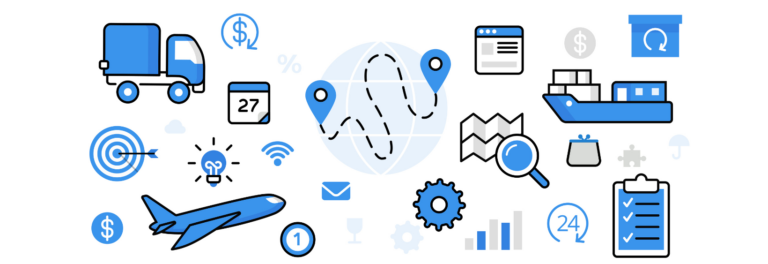The effectiveness of a supply chain hinges on its weakest component, much like the saying goes, ‘A chain is as good as its weakest link.’ In logistics and supply chain management, businesses must pinpoint and fortify the weakest link within the supply chain. Identifying and bolstering the weakest link within the logistics and supply chain management framework is at the core of supply chain risk management. A robust plan for managing logistics and supply chain management risks is essential to navigate and overcome the various challenges and uncertainties inherent in this field.

According to a 2019 report by GEODIS, 57% of companies perceive supply chain management as a strategic advantage that empowers them to advance and expand their businesses.
What Is Logistics and Supply Chain Risk Management?
Logistics and supply chain risk management (LSCRM) involves meticulous oversight and coordination of your company’s logistics and supply chain operations. This encompasses every facet of the supply chain, ranging from procurement and inventory management to distribution, all of which demand thorough scrutiny and ongoing monitoring. Your enterprise resource planning (ERP) system should encompass a comprehensive view of the entire logistics and supply chain management spectrum.
At first glance, such intensive supervision might appear superfluous, as one might assume that your suppliers and service providers have their risk management protocols in place. Nevertheless, these risk management strategies are tailored to these companies’ unique objectives and requirements and may align differently with your needs. Furthermore, an integral aspect of your supplier relationships should involve formulating contingency plans anticipating potential disruptions to your logistics and supply chain.
Logistics and supply chain risk management can be executed using conventional spreadsheets; however, many companies are turning to logistics and supply chain management software systems (LSCM software) to enhance their supply chain planning. The logistics and supply chain management process are intricate, involving numerous interconnected components, and having a centralized repository of information can significantly enhance the organization and accessibility of your efforts.
Why Is Logistics and Supply Chain Risk Management Crucial?
Your logistics and supply chain constitute the lifeblood of your business, and any disruptions can have catastrophic consequences for your day-to-day operations. Even a minor error or delay can bring your entire company to a standstill, resulting in financial losses and irreparable harm to your reputation.
Therefore, it is imperative that you pay the same level of diligence and attention to your logistics and supply chain as you do to your internal business operations. Establishing transparency and visibility across all logistics and supply chain facets enables you to proactively anticipate potential challenges, source replacements when necessary, and effectively manage customer expectations. Maintaining a well-managed logistics and supply chain is paramount to delivering the highest quality service to your customers.

Elements of Logistics and Supply Chain Management
Logistics and supply chain management (LSCM) constitute the comprehensive framework encompassing the creation and delivery of products or services, from procurement to the ultimate delivery. This intricate system includes every facet of the production process, incorporating activities at each juncture, exchanging critical information, and allocating resources that transform essential materials. In strategic planning, conducting an external analysis mapping the logistics and supply chain becomes pivotal. A thorough comprehension of the logistics and supply chain is instrumental in guiding a company’s market positioning and strategic vision for the future.
The components of logistics and supply chain management exhibit variations across different industries. In the case of a manufacturing company, the conventional logistics and supply chain journey initiates with the acquisition and extraction of raw materials indispensable for product creation. These sourced raw materials subsequently traverse from the supplier to the manufacturing facility, where they are transformed into the final product. These finished products are then conveyed to distributors at wholesale rates, subsequently finding their way to retailers. Ultimately, the retailer sells the product to the end consumer, representing the concluding stage in the supplier chain. A pivotal driving force behind the logistics and supply chain is consumer demand.
Conversely, in an e-commerce enterprise, the logistics and supply chain commence when a customer orders a product via the company’s website. Within this context, the logistics and supply chain’s primary components include a checkout cart, an ordering system, a payment system, and a delivery system. While many companies employ their proprietary payment systems, there are instances where third-party payment gateways are incorporated. Upon order placement, the warehouse is responsible for verifying the product’s readiness for delivery. Subsequently, the warehouse dispatches the product to a designated shipping company, culminating in the ultimate delivery of the product to the company’s designated destination.
50% of companies hold the view that technological advancements exert a significant influence on the operations of supply chain, logistics, and transportation.
The strategic mapping of logistics and supply chain management components effectively identifies and manages potential supply chain risks.
Types of Logistics and Supply Chain Management Risks
What constitutes logistics and supply chain management risk? The logistics and supply chain management risk definition encompasses any disruption within the logistics and supply chain that can adversely affect the overall organization, its business processes, revenue, or the production and delivery of goods and services. Any disruption to the logistics and supply chain is considered a risk. Supply chain leaders are responsible for assessing and adapting to the logistics and supply chain management risk matrix.
To effectively evaluate, oversee, and mitigate logistics and supply chain management risks, management must initially understand the various threats and their underlying causes. So, what are some of the logistics and supply chain management risks? Logistics and supply chain management risks are intertwined with economic, geopolitical, environmental, and cybersecurity factors. Here are some of the primary logistics and supply chain management risks:
Labor and Union Issues
Within the sphere of manufacturing, labor unions are prevalent. Alterations in employee contracts, wages, or work hours necessitate negotiation with unions, often resulting in extended implementation timelines. Maintaining the appropriate insurance policies is crucial to ensure minimal logistics and supply chain disruptions.
Financial Risks
Financial risks may arise from unexpected or unfavorable shifts in exchange rates. These financial risks extend to suppliers and can manifest as bankruptcies, logistic complications, unanticipated cost overruns, etc. Additional financial risks encompass budget overruns, changes in project scope, heightened funding requirements, and missed project milestones.
Supply Risks
What is meant by supply risk? Supply risks materialize when essential raw materials are not delivered punctually or suffer damage, causing disruptions in the logistics and supply chain flow.
Demand Risks
Demand risks emanate from inaccuracies in forecasting product demand, often attributed to inadequate insights into annual purchasing trends or unforeseeable market fluctuations.
Business Risks
Unanticipated changes within entities vital for the seamless logistics and supply chain operation are categorized as business risks.
Environmental Risks
Logistics and supply chain disruptions resulting from natural events fall under environmental risks. Such events encompass extreme weather conditions, pandemics, and natural disasters, which can disrupt the supply chain to varying degrees, locally or globally.
Despite the challenges posed by the pandemic, the global supply chain management market is projected to exhibit a robust Compound Annual Growth Rate (CAGR) of 11.2% from 2020 to 2027. In 2020, the market was estimated to be at $37.41 billion, indicating its resilience and continued growth potential (source: Businesswire, 2020).
Geopolitical Risks
Logistics and supply chain disruptions from global political events are classified as geopolitical risks. These risks may encompass political instability, civil unrest, protest movements, corruption, trade barriers, and tariffs, as well as terrorism or piracy. The risk magnitude increases when multiple geopolitical risks coincide.
Economic Risks
Economic risks transpire in response to fluctuations in demand, port and border delays, currency rate fluctuations, material scarcities, and price volatility. For instance, decreased demand may trigger price reductions, while shipping delays can lead to price fluctuations.
Cybersecurity Risks
Cybersecurity risks emanate from compromising sensitive business information, trade secrets, or intellectual property transmitted across the industry. Cybersecurity risks include ransomware attacks, data breaches, and intellectual property theft.

Understanding the Origins of Logistics and Supply Chain Management Risks
The initial step in mitigating logistics and supply chain management risks involves conducting a comprehensive risk assessment. Root cause analysis is a systematic approach to addressing these issues, whether from internal sources within the company’s operational domain and thus subject to management and planning mitigation or external sources, such as supplier or partner efficiency, beyond the company’s direct control.
Inefficient Adoption of Technology Trends
Industries heavily reliant on the logistics and supply chain, along with their suppliers and partners, are at substantial risk if they fail to embrace technological trends. Embracing integrated and intuitive software, encompassing areas from demand planning and forecasting to payment processing, can significantly enhance supply chain efficiency. Software solutions provide planners with comprehensive visibility across the entire supply chain, increasing customer satisfaction. Businesses neglecting to adopt such solutions heighten their exposure to supply chain risks.
According to Inbound Logistics in 2019, over 50% of G2000 manufacturing companies plan to integrate AI into their supply chain management initiatives by the year 2024.
Natural or Environmental Occurrences
Natural and environmental disasters represent one of the most formidable threats to the supply chain. These risks can inflict severe harm on businesses and often yield cascading effects on operational processes.
Inaccurate Demand Planning and Forecasting
Inaccuracies within demand planning and forecasting engender bottlenecks in the supply chain. Refrain from relying on outdated manual forecasting methods frequently leads to inaccuracies. Effective forecasting must account for factors like facility capacity, yard management, container management, and transportation management.
The Shift in Governmental Regulations
The dynamic nature of governmental regulations and policies poses an external risk to the supply chain. A sound supply chain management strategy should consider regulatory changes, including taxation, trade restrictions, border controls, and labor laws. Failure to adhere to and stay current with government regulations represents a clear supply chain risk.
Price Fluctuations
Fluctuations in prices, encompassing fuel costs, route efficiency, and port complications, can trigger supply chain disruptions. These factors directly influence transportation costs within the supply chain.
Supply Chain Risk Management Defined
The definition of supply chain risk management (SCRM) entails a strategic process aimed at helping companies identify, analyze, assess, and mitigate risks within the supply chain. SCRM processes involve distinct phases of risk identification, assessment, and mitigation.
Supply Chain Risk Identification
The initial stage in supply chain risk management involves identifying potential supply chain risks. A comprehensive risk profile is fundamental, necessitating continuous monitoring and updates to accommodate new risks.
Supply Chain Risk Assessment
Once the risk profile is established, the next step entails delineating the potential impact of each risk on the business. This risk assessment must consider stakeholders’ roles in influencing sales, margins, or profits.
Supply Chain Risk Mitigation
Precise identification and assessment of risks lay the foundation for effective risk mitigation planning. Supply chain risk mitigation strategies encompass preventive and reactive measures, serving as the basis for risk management while safeguarding and preserving the brand.
Businesses employ various supply chain risk management processes, including supplier risk management, environmental risk management, financial risk management, value chain risk management, geopolitical risk management, and demand risk management. Supply chain risk management empowers businesses to orchestrate and manage sourcing, procurement, conversion, and logistics activities. One of the primary motivations for companies to implement global supply chain risk management strategies is to secure a competitive edge.
Effective Strategies for Supply Chain Risk Management
Supply chain risk management principles are not only focused on risk mitigation but also on cost-saving measures. A comprehensive supply chain risk assessment checklist must encompass external and internal risk factors. Effective supply chain risk mitigation should contain all these facets to ensure proactive readiness for potential disruptions.
Prevention, Preparedness, Response, and Recovery Strategy (PPRR)
The PPRR model constitutes a global supply chain risk management strategy, incorporating precautionary measures, contingency planning, responsive actions, and swift resumption of regular operations in the aftermath of disruptions.
Managing Environmental Risk
While environmental factors remain unpredictable, proactive planning for environmental risks is feasible. Supply chain risk assessment software enhances proactive planning by providing deeper insights into supply chain structure.
Implementing a Logistics Contingency Plan
A robust logistics contingency plan ensures business continuity during supply chain disruptions. Businesses must establish solid contingency plans, preferably multiple projects, to effectively navigate supply chain risks.
Conducting Internal Risk Awareness Training
Cultivating a risk-aware culture significantly contributes to supply chain risk mitigation. Risk training programs should illuminate common risks, challenges, and best practices in risk management.
Continuous Monitoring of Potential Risks
Ongoing supply chain risk monitoring is pivotal in safeguarding supply chain operations. Through comprehensive monitoring at every supply chain level, potential risk indicators can be identified, leading to streamlined business operations.
Centralized Data Consolidation
Supply chain risk assessment data should be consolidated within a single, organized, and easily accessible repository.
Businesses can harness supply chain risk management technology to gain visibility into every facet of their supply chain. Adopting supply chain risk management software can enhance the effectiveness of risk mitigation strategies within the supply chain.
To conclude
Modern supply chain management’s complexities demand a strategic partner with deep expertise and a commitment to excellence. Improve Supply Chain Management with Target Integration’s expertise. Our knowledge, innovation, and dedication offer a path forward for businesses seeking to navigate the challenges of the supply chain landscape. With our guidance, companies can optimize operations, mitigate risks, and achieve greater efficiency and resilience in an ever-evolving business environment.
We are distinguished by our specialized expertise in delivering tailored software solutions through a comprehensive GAP analysis process. This approach sets us apart, enabling us to identify our client’s unique needs and requirements precisely. By conducting this thorough analysis, we ensure that the software solutions recommended align with the client’s current operations and are well-equipped to address future challenges and opportunities.



